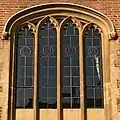Hood mould
In architecture, a hood mould, label mould (from Latin labia, lip), drip mould or dripstone, is an external moulded projection from a wall over an opening to throw off rainwater. This moulding can be terminated at the side by ornamentation called a label stop.
The hood mould was introduced into architecture in the Romanesque period, though they became much more common in the Gothic period. Later, with the increase in rectangular windows they became more prevalent in domestic architecture.
Styles of hood moulding
 Circular hood moulding
Circular hood moulding Rectangular hood mouldings on a rendered Victorian building
Rectangular hood mouldings on a rendered Victorian building Every window of the Mercer House in Savannah, Georgia, is crowned with a cast-iron hood moulding
Every window of the Mercer House in Savannah, Georgia, is crowned with a cast-iron hood moulding Tudor-style hood mould ending in decorative label stops, Magdalene College, Cambridge
Tudor-style hood mould ending in decorative label stops, Magdalene College, Cambridge
| Wikimedia Commons has media related to Hood moulds. |
References
- Burden, Ernest E. (2002), Illustrated Dictionary of Architecture, McGraw-Hill Professional, p. 213, ISBN 0-07-137529-5
This article is issued from Wikipedia. The text is licensed under Creative Commons - Attribution - Sharealike. Additional terms may apply for the media files.